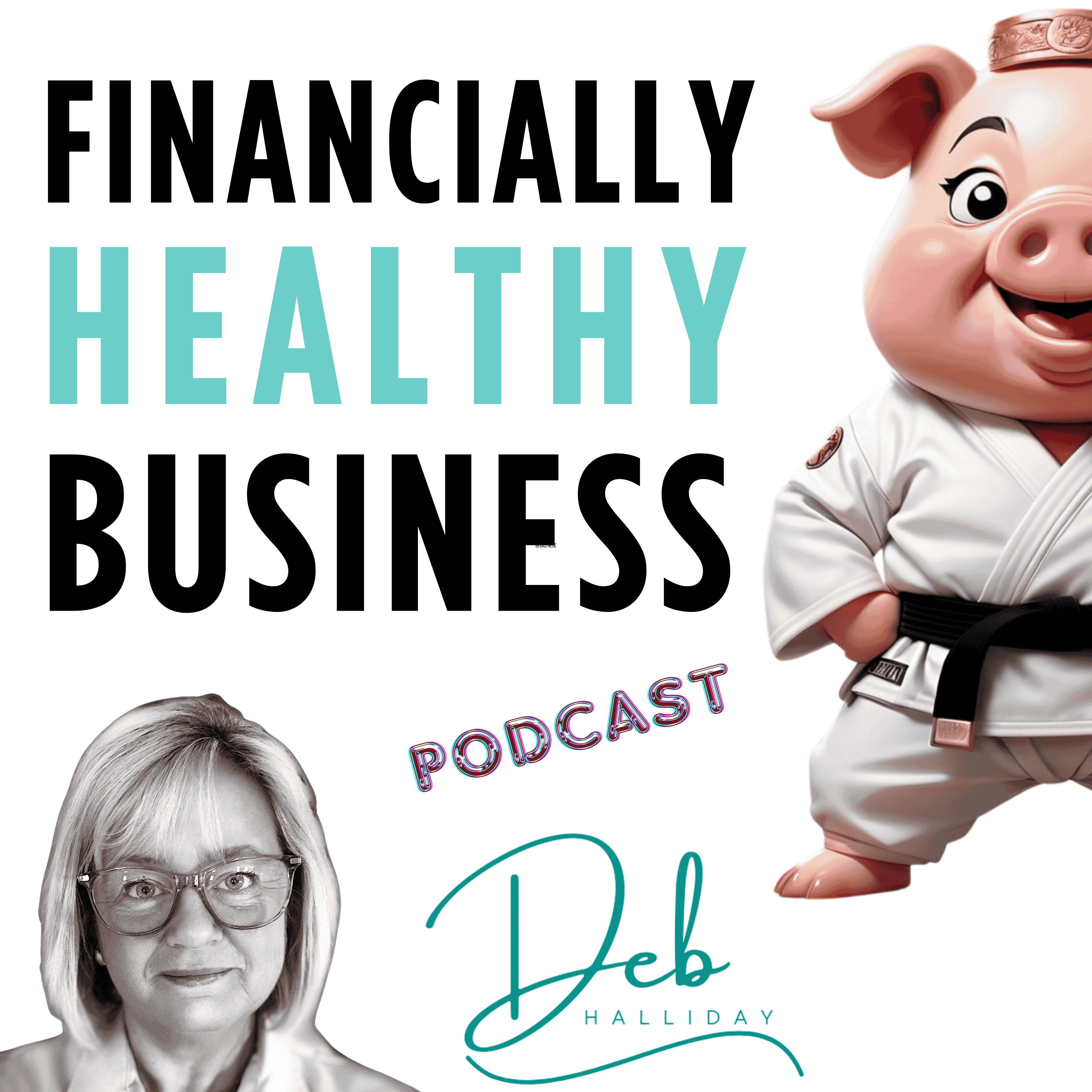Eliminating Bad Debt: A Step-by-Step Guide for Business Owners
In this episode, we’re breaking down a topic that confuses and overwhelms many business owners: business debt—and more importantly, the difference between good debt and bad debt.
I’m Deb, a Profit First Professional, and today I’m sharing how not all debt is created equal. Some debt can fuel growth and opportunity; other debt simply covers up cash flow problems and leads to long-term stress. We’ll look at how to tell the difference, and what to do when debt is holding your business back.
I also introduce you to Steve, a fictional business owner whose story represents thousands of real entrepreneurs. Steve used the Business Debt Snowball strategy to regain control and rebuild his financial confidence—and so can you.
By the end of this episode, you’ll have the clarity and steps needed to tackle toxic debt, use borrowing wisely, and build a business that truly supports your life.
About the Podcast:
This episode of the Financially Healthy Business Podcast takes a clear-eyed look at business debt—how to use it, when to avoid it, and how to get out from under it if it’s become a burden.
I explain how good debt, when used intentionally, can help you invest in systems, growth, or opportunities that move your business forward. But bad debt—the kind used to plug holes or fund overspending—can quietly drain your energy, your cash flow, and your peace of mind.
With practical steps, mindset shifts, and a step-by-step guide to using the debt snowball method for businesses, you’ll walk away from this episode feeling empowered—not embarrassed—about taking control of your financial future.
With 15–20 minute episodes packed with insight and action, this series is your roadmap to financial clarity and confidence. We follow the chapters of my book to give you structure, support, and proven strategies at every step of your journey.
Let’s transform the way you think about debt—so you can run a business that lifts you up, not weighs you down.
Takeaways:
- Effective management of business debt is crucial for maintaining financial health and stability.
- Understanding the distinction between good debt and bad debt is essential for business growth.
- Implementing a debt snowball method can facilitate the elimination of undesirable debts efficiently.
- Developing a dedicated debt repayment strategy will enhance cash flow and reduce financial stress.
- Recognizing that debt is a temporary situation, not a permanent identity, is vital for business owners.
- Regularly monitoring and adjusting debt repayment plans can lead to sustained financial improvement.
Links referenced in this episode:
Companies mentioned in this episode:
- Accounts Ladies
- Accounts Office Academy
Transcript
Financially Healthy Business Podcast for business owners who want the confidence on cash flow that supports the life they actually want to live.
I'm Deb Halliday, Profit first professional founder of award winning accountancy practice the Accounts Ladies and the Accounts Office Academy and author of how to Build a Financially Healthy Business. Learn how to take control of your finances, reduce stress and grow sustainably because your business should support your life, not consume it.
Let's get started. Welcome back to the Financially Healthy Business Podcast.
I'm Deb Halliday and this is episode six in our book based series on building a financially strong business that supports your life, not drains it. In the last episode we talked about personal debt, how to clear it and reclaim your peace of mind. Today we're looking at the other side of the coin.
Business debt. Is it always bad? Can it be useful? How do you tell the difference?
And most importantly, how do you get rid of the bad kind without sabotaging your growth? Let's dig in. Understanding Business Debt first, let's get clear on what business debt actually is.
It includes business credit cards, loans, overdrafts, equipment finance, VAT deferrals, bounce back loans. Debt in itself isn't bad. In fact, some debt is a strategic tool, especially when it's used to create revenue or value.
But there's a difference between good debt and bad debt. Understanding that difference is essential if you want to build a stable, scalable business. Good Debt versus Bad Debt let's define them.
Good debt used to invest in growth has a clear return on investment, supports revenue, productivity or time freedom Buying equipment that speeds up delivery Investing in team members to reduce burnout A short term marketing loan that brings in recurring clients Bad debt covers day to day survival, doesn't generate future income, is used reactively to plug cash flow gaps using credit cards to pay bills or wages Rolling loans over just to get through the month Borrowing to cover tax you didn't plan for Bad debt creates financial stress, it reduces flexibility and it traps you in a cycle of dependency. So how do we get rid of it? Case Study Steve's Business Debt Payoff let's go back to Steve, who you'll remember from previous episodes.
His business was thriving on the surface, but beneath it he was juggling a credit card, a loan, an overdraft and a VAT repayment plan. He felt stuck, like every month was just paying off the past. So we created a business debt snowball.
We helped Steve categorize each debt, create a repayment pot inside his profit first system. Pay off the smallest balance first, roll the payments into the next debt and continue this until every bad debt was gone.
He kept one good debt, a low interest equipment loan that helped him scale faster. The result? Lower stress, more cash flow, more freedom to invest in what mattered. How to clear business debt step by step.
Here's how you can do the same. Step 1 List all your business debts. Include credit cards, loans, finance agreements, VAT or HMRC plans. Step 2 Categorize them.
Good debt supports growth. Bad debt equals covers gaps or operating costs. Focus on eliminating the bad first. Step 3 Order the bad debts from smallest to largest.
Ignore interest rates for now. We're building momentum. Step 4 Create a dedicated debt pot in your profit first system. Allocate a percentage of income just for repayment.
Even 5 to 10% makes a difference. Step 5 Make minimum payments on all debts. Then throw all your extra at the smallest one. Once it's gone, roll that full payment into the next.
Step 6 Monitor and adjust. Reassess every 90 days as revenue increases. Increase your debt repayment rate. THE Mindset Debt is a season, not an identity.
Many business owners wear debt like a permanent label. I'm just someone who always has a loan. This is just part of growing. But debt is a season, not a sentence. And it's not a shameful one.
It's a data point. The moment you shift from reacting to debt to creating a plan for it, feeling trapped to feeling in control.
That's when your business becomes financially healthy. Debt is not a reflection of failure. It's a challenge, and you can solve it. Here's your action step this week.
List out every business debt you're carrying. Categorize it good or bad. Start building a debt pot in your accounts. Commit to paying off the first balance using the snowball method.
For resources, visit ww.how to build a financiallyhealthybusiness.co.uk debt freedom gives you cash flow, it gives you confidence, and it opens the door to true growth.
Next time, we're getting into one of the biggest game changers of all pricing how to stop undercharging, ditch hourly rates, and finally, price for real profit. Thanks for being here. Remember, you're not your numbers, you're the person transforming them. I'm Deb Halliday. See you in the next episode.
Thanks for tuning in to the Financially Healthy Business Podcast. If today's episode helped you take a step closer to building a business that supports your life, share it with a fellow business owner.
Follow the show or leave a review. It all helps to get the message to the people that need it.
Head to how to build a financiallyhealthybusiness.co.uk and explore the tools, resources and online programs. You didn't start your business just to survive, you started it to thrive.

